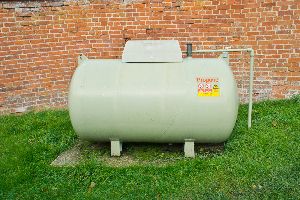
Propane is a reliable fuel for heating systems and other appliances. Tanks store this gas and are connected to the system, so you have the supply you require when you need it. Below is a breakdown of some of the most important components of propane tanks.
What Are the Main Propane Tank Components?
1. Fill Valve
The fill valve is where the delivery driver hooks up the hose from the truck to the tank. The seal from the hose’s end must be set firmly against a necessary black gasket to ensure no gas escapes as the tank fills.
The pressure from the gas opens the fill valve located inside the tank as well as the one-way valve visible on the outside. These two valves together ensure there is no backflow, so the gas is safely delivered into the holding tank. If the gasket is missing, a delivery cannot be made.
2. Safety Relief Valve

If there's too much pressure in the tank, the safety relief valve reduces it. These are controlled by a spring. If pressure is less than the pressure of the spring, the valve stays closed. If pressure becomes more than the spring, the valve opens enough to provide relief, and a hissing sound can be heard.
For extremely high levels of pressure, it opens completely with a loud pop and a full stream of propane. The valve closes when pressure is back to safe levels. If moisture hits this spring, it can lead to corrosion and can cause the valve to malfunction.
3. Service Valve
This is where the propane vapor enters gas pipes for use in your appliances. Because this valve allows the gas into the home, there is an LP gas regulator that acts as a safety element to reduce pressure that occurs from the gas line, making it secure for use in appliances.
Over time wear and tear can lead to a malfunction or leak, and a replacement is needed. If you smell gas, turn the valve off and call the gas company.
4. Gauges
There are two critical gauges on the tank. The face or dial gauge tells you how many gallons of gas are present, usually displayed as a percentage. The other is the fixed liquid level gauge, also called the bleeder valve, and is mainly used by gas delivery technicians.
When it reaches 80%, it tells the service team that the tank is reaching fill capacity. There's also a float gauge that measures the tank’s volume as a percentage of its total capacity. Wear and corrosion can affect their function, but to replace these gauges the tank must be emptied first.
For propane for your home or business, Tri-County Propane has you covered. Located in Loveland, OH, their efficient propane delivery options ensure you have enough fuel for your property’s needs. Their professional team provides emergency services as well as propane gas tank repairs to keep equipment running well. Call (513) 583-1868 to get started or visit them online for more.
About the Business
Have a question? Ask the experts!
Send your question

